Film: Weekend of Shadows in Macclesfield
“Weekend of Shadows” - a powerful film released by the S.A. Film Corporation and Samson Productions - holds special interest for the people of the Hills. Much of the filming in 1977 was carried out in and around the township of Macclesfield and many local people were “extras.”
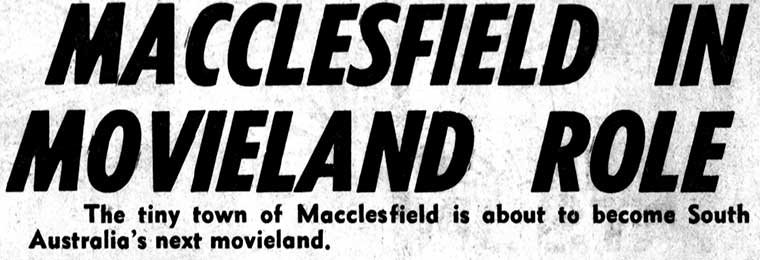
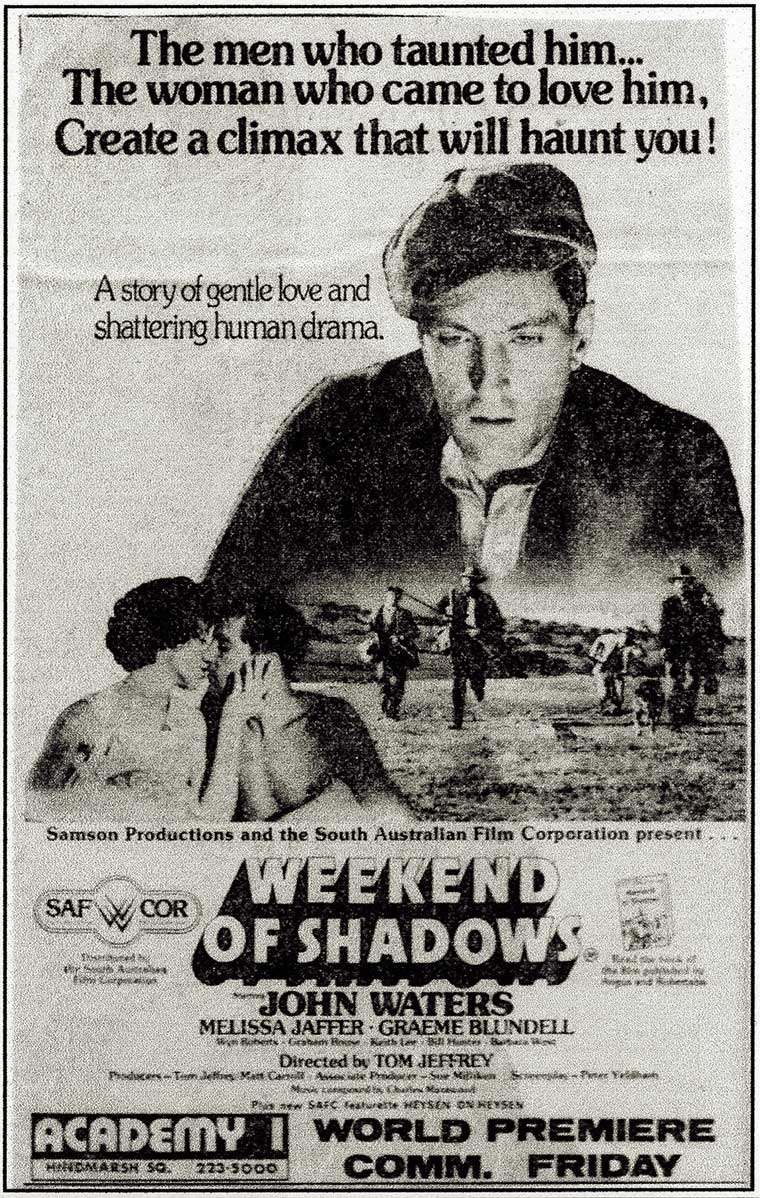
Below is a selection of The Advertiser and Macclesfield Newsletter articles and images from then and more recently.
Before the filming, the week before July 16th 1977:
The town of Macclesfield is to be the setting of a full-length Australian feature film, “Weekend of Shadows”.
The producers are hoping to cast about 200 local men, women and children in the crowd scenes.
The film is a psychological, action drama to be co-produced by the S.A. Film Corporation and the Sydney company, Samson Productions, with a budget of $500,000.
Filming begins on August 1, but the search for “extras” will take place next Saturday, July 16th.
Miss Hilary Linstead, who is in charge of location casting, will be at the Macclesfield Institute from 9am to 5pm to interview anyone interested in taking part in the film. Children should be 11 years or older.
For those selected, it will be a chance to appear in and be involved in the production of a major feature film and work alongside some leading Australian actors. The major roles will be played by John Waters, well known from the television series “Rush” and the films “Eliza Frazer” and “End Play”. Co-star is Melissa Jaffer who appeared in the film “Caddie” and has played many roles in stage and television.
The director of “Weekend of Shadows” is Tom Jeffery who is co-producer with Matthew Carroll of the S.A. Film Corporation which produced “Storm Boy.” The producers pointed out that as the film is set in the 1930’s, all the men including the stars will have short back and sides haircuts.
There is also a feature spot in the film for a local 50-50 old style dance band and any groups interested should also go along to the Macclesfield Institute next Saturday.
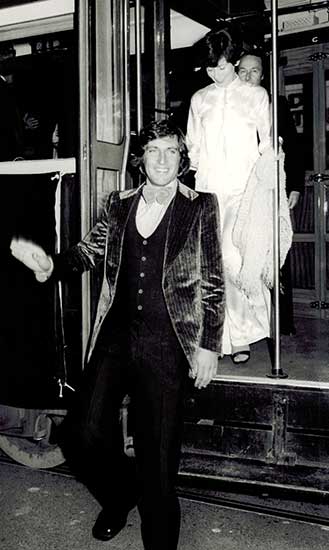
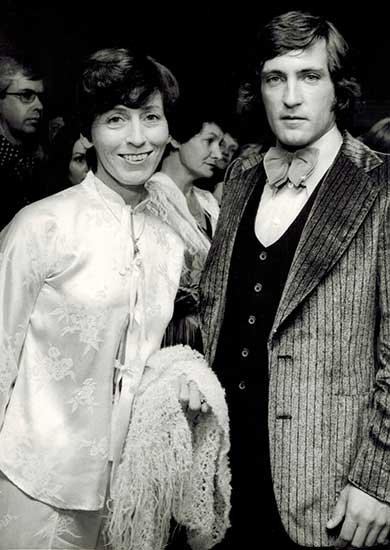
Stars John Waters and Melissa Jaffer arrive on the tram to 'sneak preview' of the movie
John Waters and Melissa Jaffer at Movie Premiere
The lush green countryside and the old buildings look particularly attractive on the large screen... but “Weekend of Shadows” is far more than just a pretty picture.
The story revolves around a hunt for a supposed murderer, a Polish farm-worker. It exposes very cleverly the feelings of suspicion and hostility of the local community for the “alien.”
Set in an Australian country town in the 1930’s, the film has several delightful scenes of typical Australian-style humour, which lightens the growing tension.
“Weekend of Shadows” is a film which undoubtedly leaves the audience thinking. The dramatic and unexpected ending is stunning in its impact. Be warned, for days afterwards you will be asking “why”...looking into the well depicted characters for reasons why they acted as they did. The people of the town - Caxton, the police sergeant; “Rabbit,” introverted, inarticulate, but deeply thinking; their wives, the schoolmaster, the men who join in the hunt - are portrayed with great skill and accuracy.
John Waters plays the role of “Rabbit,” while Melissa Jaffer is his wife Vi, Wyn Roberts is the sergeant, Eric Caxton and Barbara West, his wife. The men taking part in the hunt include Graeme Blundell, Graham Rouse, Bill Hunter, Keith Lee, Les Foxcroft and Kit Taylor. The Pole, rarely seen is played by Mark Gaweda.
Director is Tom Jeffrey, who is also co-producer with Matt Carroll. The screen-play is by Peter Yeldham. The S.A. Film orporation has obviously produced a film that will be enjoyed over by many people. If as expected, it will reach the overseas market, however, we wonder just what kind of light this stark picture of the Australian character (albiet of 40 years ago) will be received.
You can just imagine the excitement and all the talk and banter in the village that would’ve surrounded those first few days when the news hit that a film was going to be made right here in Macclesfield.
The Macclesfield Institute was to be the scene for registration of names for bit-parts as many local people would receive bit playing roles and of course many homes and buildings would be included in the scenes.
Some buildings were “converted” while others received special coats of paint etc to blend in with the story. Geoff & Elvia Adams’s house became the Police Station and Jack Tavener’s house in Cunliffe Street became Rabbit & Vi’s house, the main house to be filmed inside and outside. Strathfields Garage and the garage of Matschoss Motors were converted somewhat as was the Post Office and General Store. The Macclesfield Hotel became “The Railway Arms Hotel”.
“It all began the day I registered my name” said Faye Davis. “I was most surprised to receive a visit from the Production Manager” on a Tuesday to see if I was still available for the following Friday at 5 o’clock. 5 in the morning that is.” Making all the arrangements for the children etc Faye and Erica Calaby with hair in rollers arrived at the Hall at 5am ready for make-up. Racks of dresses and tables full of shoes, hairdressers, make-up artists, TV cameras, dogs and all and sundry made a very exciting and busy place indeed. Signing onto Actors Equity, dressing up in 1930’s dresses and coats and told to take a texta and draw the seams up the back of their pantyhose and be ready to go out to “the set” before dawn. “The next morning was also a 5am start involving several other local ladies” said Faye, “My next scene was a week later, involving my husband and many others, to film the dance sequence.”
“Back in June I first heard there was a film about to be made in Macclesfield. They wanted boys aged 11 and under. I was interested and hoped that I would get a part” said Paul Cooper 11. “The day came when Mum got a phone call saying I was to be in the film. Friday I went down to film and they had everything set up. A couple of boys had to chase “Rabbit” across the bridge to the creek and pull his pants down and say Rabbit Rabbit got a nasty habit & laugh at him. At the end of the day I said to Mum, it was hard work.
“What excitement! A phone call from the S.A. Film Corporation asking if I’d be available at 5 am the next morning for a dawn scene. Of course I’d be available” said local lass Erica Calaby. “All I had to do was organise Trevor and the children, so my day could be free.” Phoning some understanding relatives and also a very good friend, I soon had all the organisation in place and at 4.45 am next morning, and with her hair set in rollers, she joined lots of other traffic in driving down into Macclesfield, where the main street was already full of cars, people, & plenty of dogs.
“Our makeup was slapped on with a sponge - only a base, no lipstick or eye makeup. Then our hair was styled in 1930’s fashion, flat on top and sides and rolled in at the back” she said. “The dresses were something else! Lots of beading and raised embroidery in swirls and flowers down the front and gored shirts, heavy overcoats, gloves and laced up shoes completed our outfits.” Scenes like this were repeated many times, and by many local folk, as they were prepared for their various roles in the making of the film.
The first dawn scene, once the light was right, was the men going off to hunt for the murderer, while the dogs were to get stirred up, finally having a fight with their owners trying to control them. After quite a few practices and a few takes, Tom the producer was pleased and after about an hour it was “in the can” and it was time for breakfast, and what a spread was provided for the stars and the extras, who had to wait their turn after the stars. Lots of bacon and eggs, toast, tea & coffee and time to sit for a chat with the very friendly stars. Some more filming and then lunch, with still more scenes later on. Putting our names on our dresses for tomorrow, we were feeling like ‘old hands’ at this business, and able to help the new girls the next day, said Erica.
Apart from the main street of Macclesfield, other places where scenes were filmed were the old footbridge, the house of Jack Tavener in Cunliffe Street, and ‘Target Flat’. Some scenes were also filmed at the Blakiston Church amongst other areas.
Ticket to the World Premiere
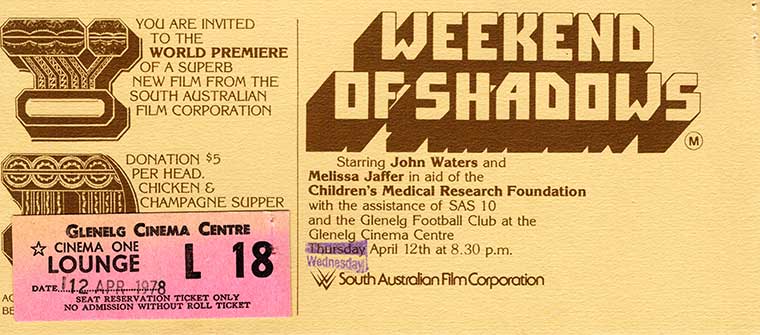
From “The Advertiser”, Tuesday, April 4, 1978
Sunday afternoon down at the Academy twin cinemas was just like a super-sized home movie evening. But instead of holiday snaps and family portraits, residents of Macclesfield and other Adelaide Hills communities watched a “sneak” preview of the South Australian Film Corporation’s latest production - “Weekend of Shadows.”
In spite of the big screen, a stable of stars and lapfuls of liquorice allsorts, Sunday’s preview had the intimacy of a family film show. Comments of “there’s so-and-so” and “doesn’t the place look good” greeted each new scene. “I wish we had all that much grass now,” muttered Arthur Edmonds, as the lush pastures of last winter sprang to life on the screen.
Up in the back row a phalanx of long-time Hills residents oohed and aahed over the scenery they have been living in for more years than most of us can muster. “We see this scenery everyday,” Mrs Voila Lowe said afterwards. “But you just don’t appreciate it in real life - the film really brings home the beauty under our noses.” .........(well you can say that again! ed.)
Samson Film Services made a donation of $200 to our Recreation and Grounds Committee as a gesture of thanks to the people of Macclesfield for their generous co-operation.
It must have been a very exciting time in Macclesfield during the making of this film and it is a bit hard to imagine just how the town coped so well with all the interruptions to the normal happenings in the town and, how all the “extras” managed to settle back into their normal daily routines again after all the excitement, the bright lights and the crowds once it was all over and the dust had settled.
We hear that some of them went out afterwards and bought new ‘necessities’ for the house or the garage, with the small sums that were paid on a daily basis for their parts in the movie, but so far we haven’t heard of any of the locals going on to further their new found careers. However, of course we have seen more of the likes of the stars John Waters and Bill Hunter for instance.
There is a lot more could be said and in fact a book could no doubt be written about all the experiences etc. There is quite a big book in the History section of the Macclesfield Institute and if you ever want to see more pictures or read the articles just ask, that is why these things are kept.
Synopsis, from "The Australian Women's Weekly", June 21, 1978.
The story was adapted for screen from “The Reckoning", a novel by Australian author Hugh Atkinson. Atkinson's novel was set in a town with a quarry. Director Tom Jeffrey found the South Australian town of Macclesfield in the Adelaide hills, with its old brickworks, an ideal setting and adjusted the script and location to suit.
The film revolves around a bush hunt for a murder suspect. It’s an action-drama set in a small country town. Its theme - the difficulty in a small community in coping with people who are strange or different.
It opens with a tranquil rural scene of a boy cycling to an isolated farmhouse. He finds the farmer’s wife violently murdered. The murder, and the hasty assumption that an itinerant Polish worker at the farm is to blame, leads to the search, which, although it takes up three-quarters of the film’s 95-minute run, doesn’t stretch the viewer’s endurance.
Police sergeant Eric Caxton (Wyn Robertsi) instigates the search for the Pole (Mark Gaweda} who has disappeared. He calls for volunteers and the local brickworkers, roused by their Saturday afternoon spree of boozing and punting, rally with roughneck enthusiasm.
One reluctant partipator is Harry Baker (John Waters), who is generally known as ‘Rabbit". He is regarded as dim-witted and is mocked because he is introverted and inarticulate. He has ignored these attitudes as he has never felt threatened.
John Waters gives a strong and sensitive portrayal of “Rabbit” a peaceful and gentle loner, deeply involved in a warm family relationship with his wife Vi (Melissa Jaffer) and son Harry. Vi persuades him to join the search and “be like everyone else.” She wants the town to accept and respect him.
The search starts off in an orderly enough way but it is soon obvious that the party is unfit for the travails of bush travel. As their dissatisfaction grows, bearded bully Bosun (Bill Hunter), leads them in rebellion against the Police Sergeant.
The film comes to a totally unexpected and stunning conclusion. Querying how it MlGHT have ended could provide a good conversation piece.
Images
Cast and crew at the 'Police Station'
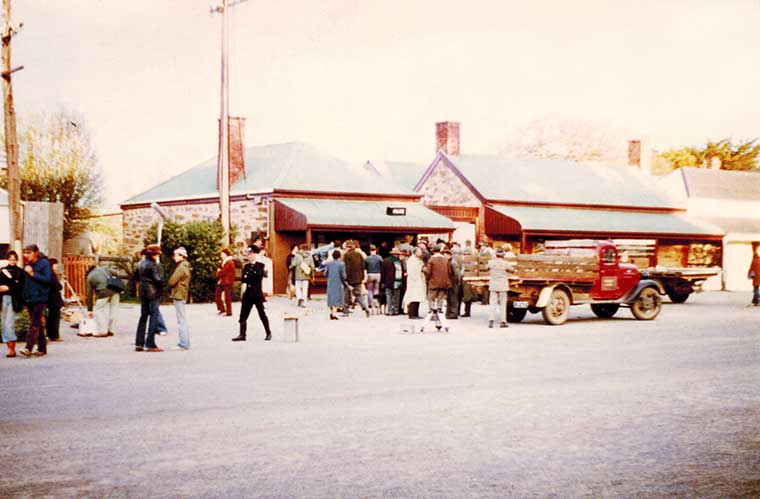
Ready for The Dance
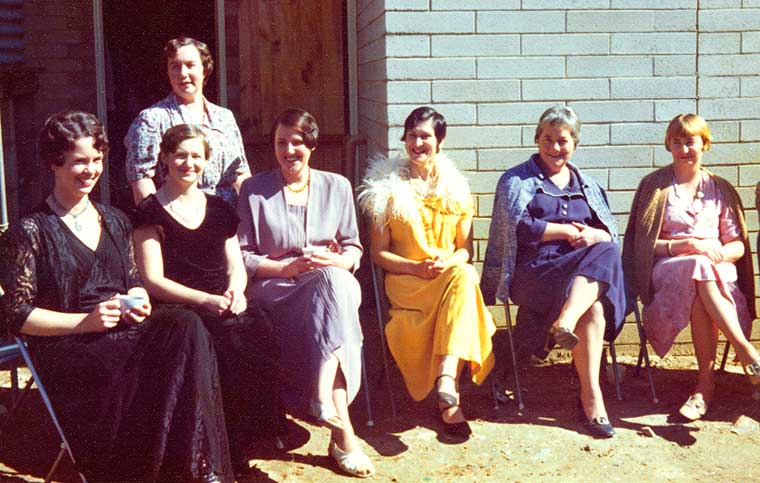
L to R front: Kay Bowey, Helen Peterson, Faye Davis, Mrs Rowe, Voila Lowe, Pat Francis. rear Gillian Thomas
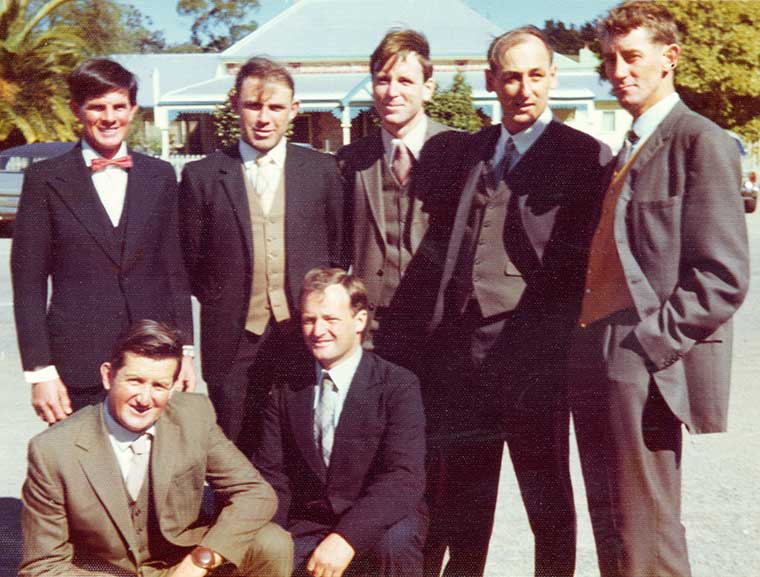
L to R: Barry Davis, Bruce Bowey, Martin Wright, Graham Thomas, Lloyd Mitchell
Front Trevor Calaby, Geoff Peterson
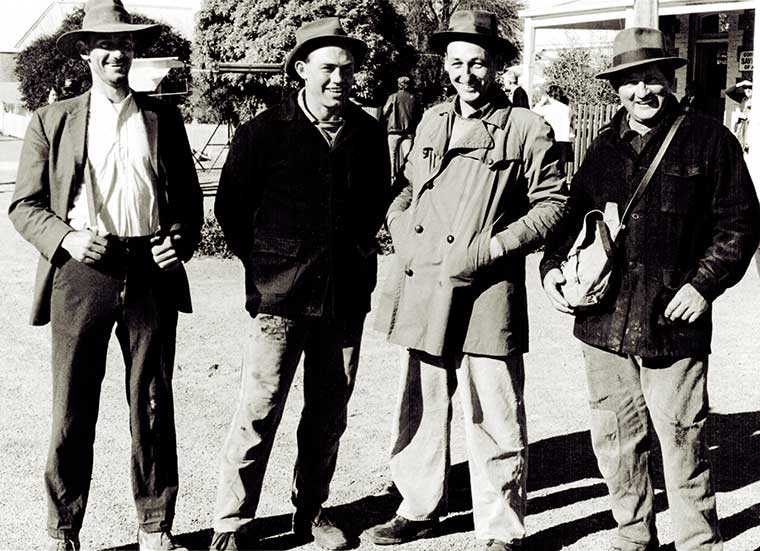
Lloyd Mitchell, Bruce Bowey, Graham Thomas, Colin Davis
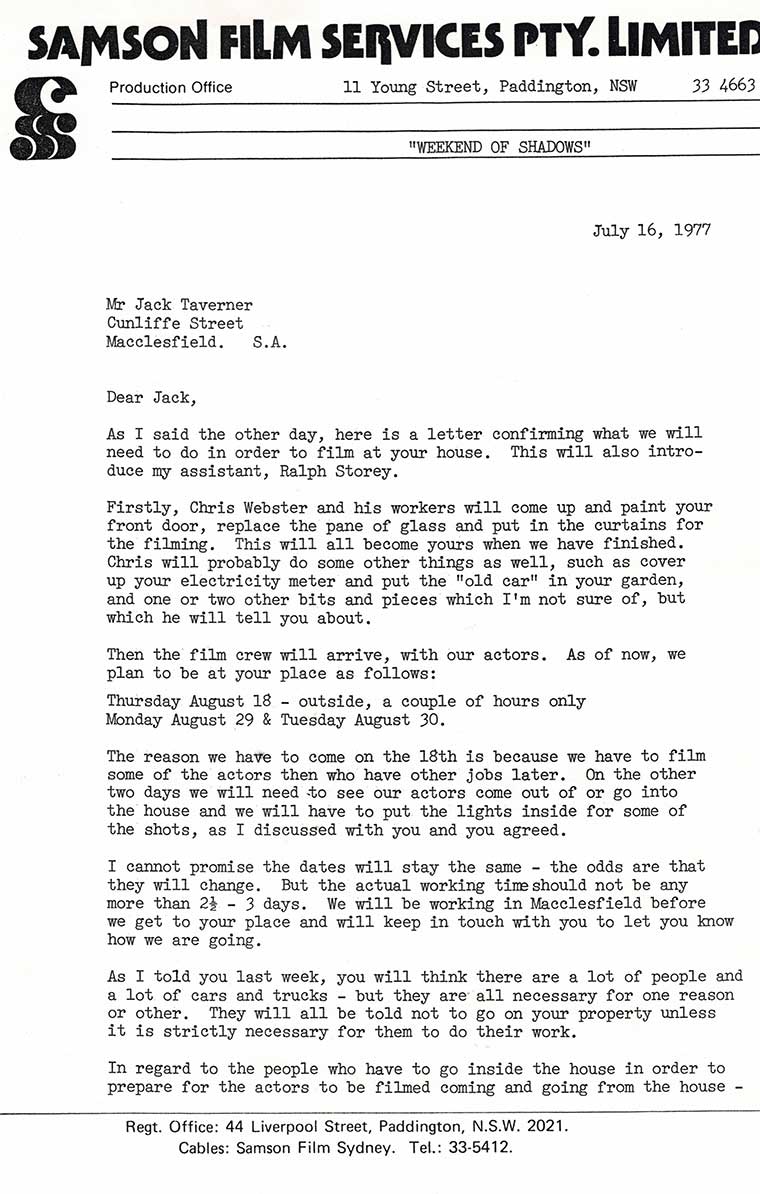
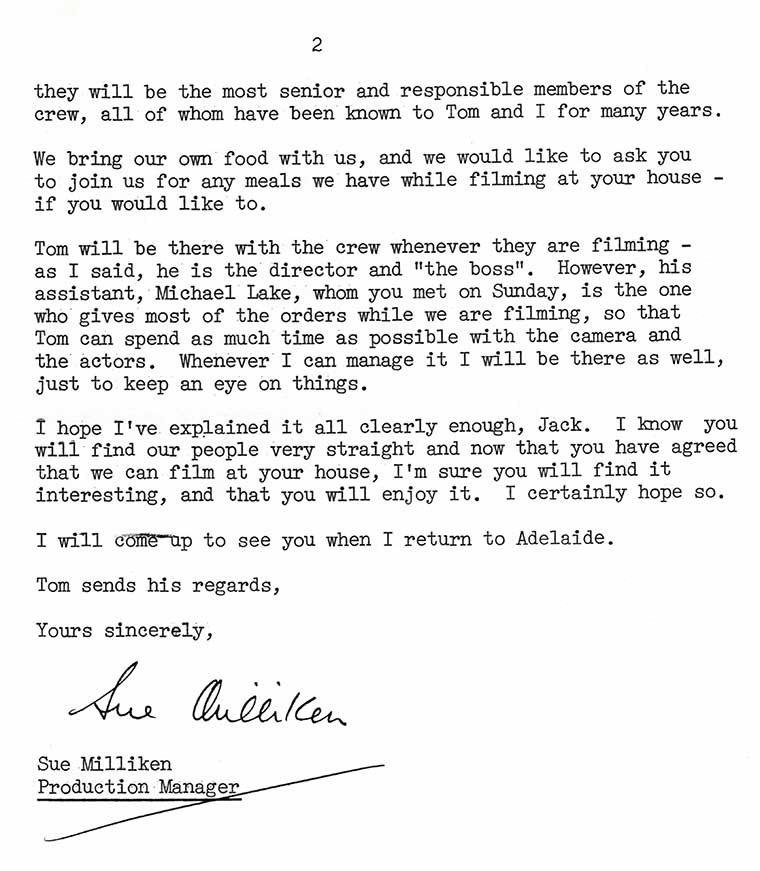
Rabbit's House
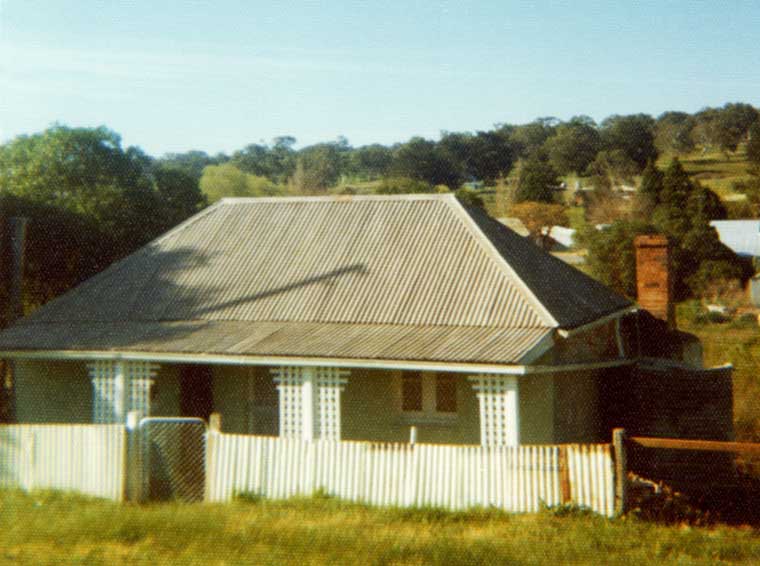
Roll the cameras
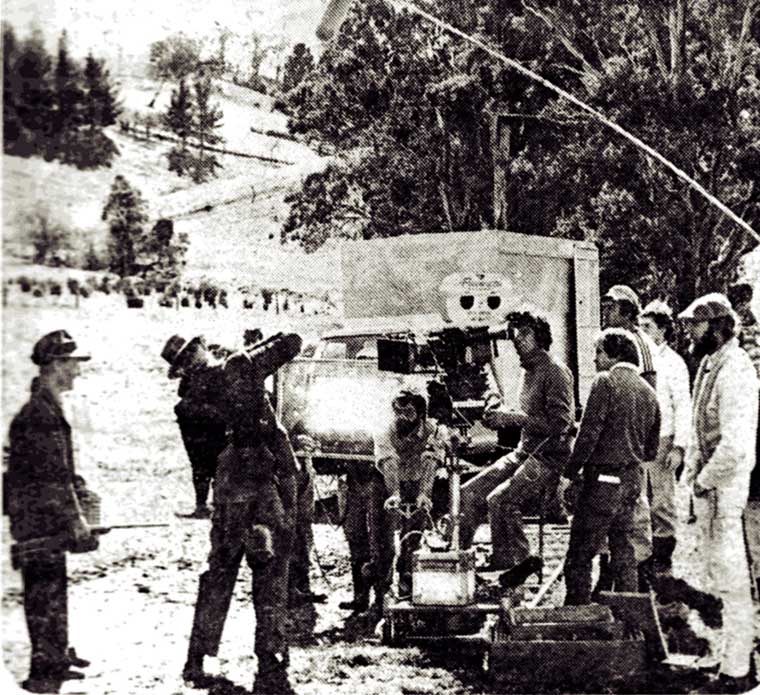
Extras
-Colin-Stacey-in-truck.jpg)
Ian Jarrad, who?, who?, and Colin Stacey in the truck. Colin suspects (31 Aug 2015) that the bike rider is probably Don Heading. Colin is playing the part of Harrigan, driving his own '32 Bedford truck that he managed to get going again, and was paid 40 pounds for what he called 'a few minutes work', though there was a lot of sitting around waiting.



